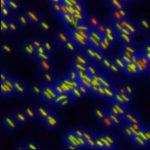Link to Pubmed [PMID] – 23793585
Curr. Top. Microbiol. Immunol. 2013;374:135-61
A long-standing and fundamental problem in microbiology is the non-trivial discrimination between live and dead cells. The existence of physically intact and possibly viable bacterial cells that fail to replicate during a more or less protracted period of observation, despite environmental conditions that are ostensibly propitious for growth, has been extensively documented in many different organisms. In clinical settings, non-culturable cells may contribute to non-apparent infections capable of reactivating after months or years of clinical latency, a phenomenon that has been well documented in the specific case of Mycobacterium tuberculosis. The prevalence of these silent but potentially problematic bacterial reservoirs has been highlighted by classical approaches such as limiting culture dilution till extinction of growing cells, followed by resuscitation of apparently “viable but non-culturable” (VBNC) subpopulations. Although these assays are useful to demonstrate the presence of VBNC cells in a population, they are effectively retrospective and are not well suited to the analysis of non-replicating cells per se. Here, we argue that research on a closely related problem, which we shall refer to as the “non-growing but metabolically active” state, is poised to advance rapidly thanks to the recent development of novel technologies and methods for real-time single-cell analysis. In particular, the combination of fluorescent reporter dyes and strains, microfluidic and microelectromechanical systems, and time-lapse fluorescence microscopy offers tremendous and largely untapped potential for future exploration of the physiology of non-replicating cells.

